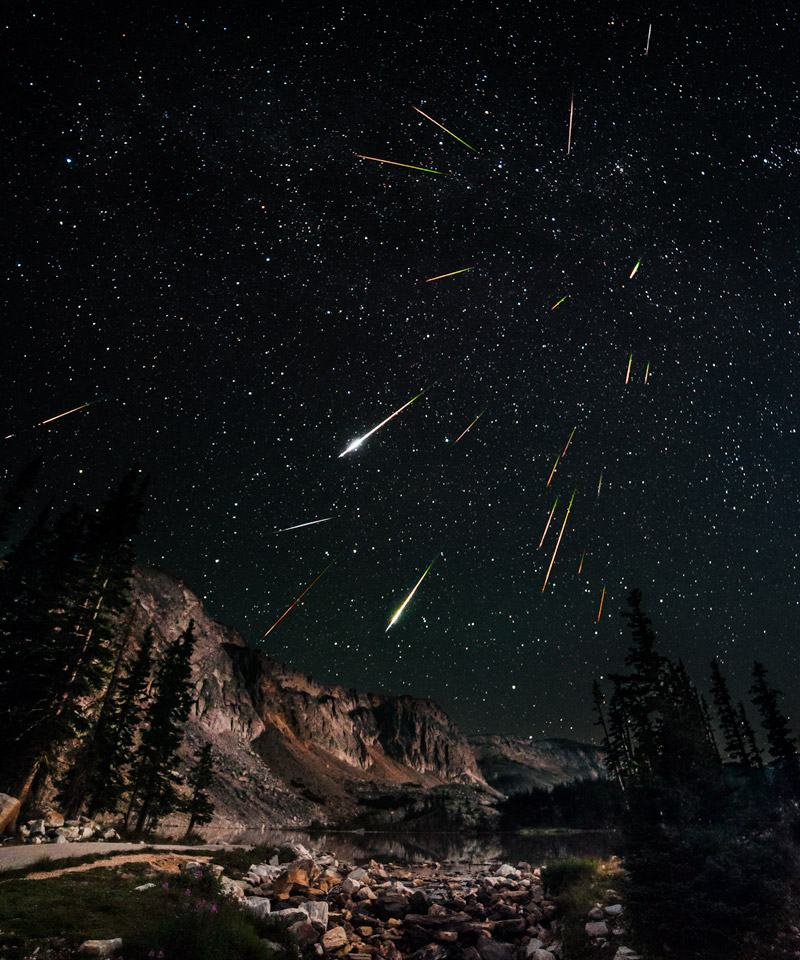
(Looking for last month’s ‘Night Sky’? Find it at this link…)
Mars and Mercury lie low in the western sky after sunset, while Jupiter and Saturn grow bigger and brighter in the southeastern and southern sky in August. The ringed planet reaches opposition late in the month. There are two full Moons this month, both about 7% larger than average. But the Moon mostly gets out of the way when the reliable Perseid meteor shower peaks on August 12-13. Here’s what to see in the night sky this month…
1 August 2023. Full Moon, 18:23 UT (‘Full Sturgeon Moon’)
3 August. The waning gibbous Moon sits about 3o south of Saturn over the southern and southwestern horizon before dawn.
8 August. Last Quarter Moon, 10:28 UT
8 August. Jupiter, lagging Saturn by two zodiacal constellations this year, lies about 2o from the last quarter Moon in the constellation Aries. Jupiter continues to increase in size and brightness on the way to opposition.

9 August. The Moon is just 2o from the Pleiades star cluster in the eastern sky as dawn arrives, with Jupiter not far away.
10 August. Look for Mercury and Mars, both tiny and low, in the western sky after sunset. The two planets lie about 5o apart. You will need a pair of binoculars to spot them. Mars now shines at magnitude +1.8, as dim as it ever gets.
11 August. The waning crescent Moon finds itself between the ‘horns’ of Taurus in the eastern sky before dawn.
12-13 August. The Perseid meteor shower peaks. This is the finest meteor shower of the year for northern stargazers, with 40-60 meteors per hour visible at the peak in the hours before dawn on August 13. Once called the Tears of St. Lawrence, this meteor shower occurs as the Earth moves through a stream of debris left by Comet Swift-Tuttle. This year the Moon is a waning crescent and mostly stays out of the way for the best part of the shower. You get the best view after midnight on August 12 and into the morning of the 13th. Stay away from city lights, if you can, and you will be rewarded with a bright meteor every minute or two.
13 Aug. As you’re out in the early morning watching for meteors, see the waning crescent Moon in the eastern sky form a triangle with Castor and Pollux, the two brightest stars of Gemini.
13 August. Venus reaches inferior conjunction as it lies between the Earth and the Sun. The planet appears about 7.7o south of the Sun today but is nearly impossible to see. In the coming days, if you have a go-to telescope and you are extremely careful not to accidentally look at the Sun, you can try during daylight hours to spot the planet’s slender crescent which spans a huge 57”. The planet emerges clearly visible in the morning sky by the end of the month and remains there for the next several months.
16 August. New Moon, 09:38 UT

18 August. The Moon returns to the western evening sky as a slender crescent and lies just 1o away from dim Mars in the fading twilight. Again, you will need a pair of binoculars to see the two.
24 August. First Quarter Moon, 09:57 UT
24 August. The first quarter Moon occults the bright red supergiant star Antares in the constellation Scorpius. The event is visible for much of the U.S., southern Canada, and northern Mexico. The rest of the world sees the two objects very close to each other. Find precise timings for the occultation at this page.
27 August. Saturn reaches opposition and rises in the east as the Sun sets in the west. The planet lies in the constellation Aquarius as it makes its closest approach to Earth this year. The planet lies about 12o south of the ecliptic, so northerner observers need steady air to get good views of its magnificent ring system. But it’s worth the effort: Saturn is one of the most beautiful objects to observe in a telescope. At opposition, its disk spans about 19” and its rings about 44”. The rings are tilted just 8o to our point of view this year. Our Saturn Observing Guide will help you get a good view of this lovely celestial object and understand what to look for. Saturn remains visible through the rest of the year.
31 August. Full Moon, 01:38 UT. The second full Moon of the month is often called a ‘Blue Moon’. This one occurs with the Moon near perigee, its closest point to Earth, so it appears about 7% larger than average.